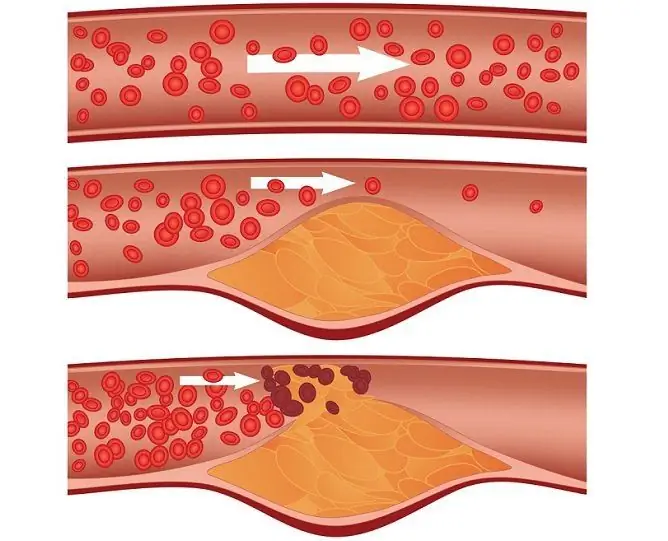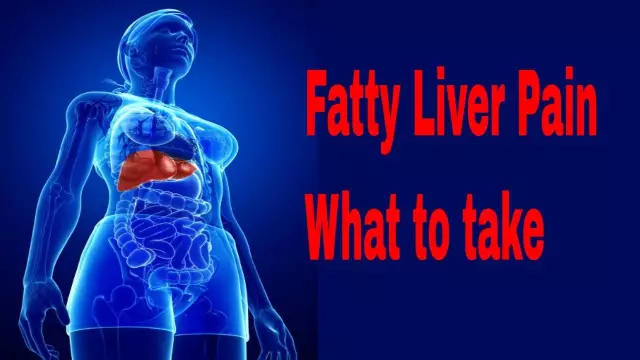- Author Rachel Wainwright [email protected].
- Public 2023-12-15 07:39.
- Last modified 2025-11-02 20:14.
Cardiomyopathy
General information about cardiomyopathies

Cardiomyopathy is a collective name for a number of diseases, the main manifestation of which is changes in the heart muscle. The exact reasons for the development of this process are unknown, but now doctors have learned quite accurately to distinguish cardiomyopathy from other pathologies and defects of the cardiovascular system. The diagnosis of primary or secondary cardiomyopathy is made in cases where changes in the heart muscle are not associated with congenital malformations, valvular defects, systemic vascular diseases, pericarditis, arterial hypertension and rare pathologies in which the cardiac conduction system is affected.
Currently, there are three types of lesions of the heart muscle: dilated, restrictive and hypertrophic cardiomyopathy. As a rule, specialists can make an accurate diagnosis already at the early stages of the pathological process, or at least have an idea of the direction in which they should move to establish the causes of the disease. Note that in a number of cases it is not possible to determine why cardiomyopathy appeared in children. In such a situation, doctors talk about the development of an idiopathic form of the disease. Despite significant differences, all of the above cardiomyopathies have a number of common features:
- lack of signs of the development of inflammatory reactions;
- tendency to form blood clots;
- enlarged heart;
- Difficulty treating heart failure, which is commonly caused by cardiomyopathies.
So, you got some idea about the characteristic signs of the disease in question, more precisely, the group of diseases. Now let's talk about each form of cardiac pathology in more detail, but first, let's dwell on the methods of their diagnosis.
Diagnosis of cardiomyopathies
The main method for determining the presence of cardiomyopathy is ultrasound examination of the heart. In 40% of cases, ultrasound allows an accurate diagnosis to be made already at the first examination. An enlarged heart can also be detected radiographically. The ECG, in turn, does not show any specific signs of the development of cardiomyopathies and therefore is not suitable for diagnosis. Laboratory studies also provide little data. Thus, with the diagnosis of cardiomyopathy, the causes of the pathology are revealed only with the help of ultrasound and, in part, X-ray examination. We also note that in the process of diagnosis, doctors may use some other methods, but only to control the effectiveness of the treatment therapy.
Dilated cardiomyopathy
Violation of the contractile function of the myocardium and at the same time a pronounced expansion of the heart chambers are signs that a person has developed dilated cardiomyopathy, which is now widespread (symptoms occur in 5-10 cases per 100,000 population). The emergence of this form is usually associated with a genetic predisposition and poor heredity. This partly explains why dilated cardiomyopathy is common in children.
The causes of the appearance of pathology are not fully understood. In recent years, the idea has been increasingly expressed that its development is provoked by various infectious agents, toxic poisoning, metabolic and immune disorders in the body. Nevertheless, despite serious advances in the field of diagnosis, when diagnosing dilated cardiomyopathy, treatment is still a problem due to the inability to understand the cause of the pathology in more than half of the reported cases.
If we talk about the most common provoking factors, then these days, of course, these include alcoholic beverages. Alcoholic cardiomyopathy is one of the most common secondary dilated cardiomyopathies. it is quite dangerous, because if patients continue to drink alcohol, despite the doctor's prohibition, 75% of them will die within the next 3 years. Such an unfavorable prognosis is due to the fact that alcoholic cardiomyopathy affects not only the myocardium, but also other parts of the cardiovascular system, causing multiple pathologies.
Dilated cardiomyopathy - disease symptoms
- dyspnea;
- fast fatiguability;
- swelling;
- blue discoloration of the skin;
- signs of heart failure
Dilated cardiomyopathy - treatment of the disease
The main therapeutic measures are aimed at combating heart failure and preventing complications. Blood pressure is reduced with ACE inhibitors (the most commonly used drug is enalapril). Also, the myocardium is exposed to small doses of alpha and beta blockers. At the same time, diuretics are prescribed to patients. Because dilated cardiomyopathy has a poor prognosis, patients are considered candidates for heart transplantation.
Hypertrophic cardiomyopathy
With an increase in the wall thickness of the left ventricle, patients are diagnosed with hypertrophic cardiomyopathy. The most likely cause of the development of pathology is genetic defects, however, in recent years, not only congenital cardiomyopathy in children, but also an acquired form in adults, whose relatives have never suffered from such heart defects, has been increasingly detected. Symptoms of the hypotrophic form:
- dyspnea;
- pain in the left side of the chest;
- unstable heart rate;
- tendency to faint.

Hypetrophic cardiomyopathy is very dangerous, as it leads to irregular heartbeat and sudden death. In some patients, heart failure rapidly develops, which also poses a serious threat to life. Accordingly, when diagnosed with hypertrophic cardiomyopathy, treatment is aimed at improving the functions of the left ventricle and restoring its normal performance. For this purpose, patients are prescribed verapamil, beta-blockers, a pacemaker for constant cardiac stimulation. In contrast to the dilated form, hypotrophic cardiomyopathy has more favorable treatment prognosis and a low mortality rate of patients.
Restrictive cardiomyopathy
Relaxation of the myocardial walls and dysfunction of the heart muscle are the main symptoms of restrictive cardiomyopathy. The causes of the disease in most cases cannot be identified. In addition, secondary rectal cardiomyopathy, whose symptoms are similar to many other diseases of the cardiovascular system, is very difficult from the point of view of correct diagnosis. In fact, in many patients, complaints of cardiac dysfunction occur only in the late stages of the disease, when the process of heart failure is already in full swing. Keep in mind that in the case of most patients, swelling and shortness of breath on the slightest physical exertion are the cause of complaints.
Like dianostika, the treatment of restrictive cardiomyopathy is challenging due to the late correct diagnosis. During this period, a heart transplant rarely leads to the desired result, not to mention standard medications, the effectiveness of which tends to zero. As a result, the mortality rate of patients with restrictive cardiomyopathy reaches 70% within the first 5 years after starting treatment.
YouTube video related to the article:
The information is generalized and provided for informational purposes only. At the first sign of illness, see your doctor. Self-medication is hazardous to health!






